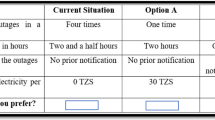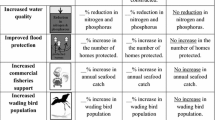Abstract
In a split sample design, we examine how the number of choice sets, design of the first choice set (context dependence), and the choice of attribute levels in the cost attribute affect the precision in the elicited preferences in otherwise completely identical choice experiment surveys. These issues are investigated for Swedish households’ marginal willingness to pay to reduce power outages. Our results indicate that neither the number of choice sets nor the design of the first choice set has a significant impact on estimated marginal willingness to pay, while the effect was significant for the additive scaling of the cost vector. At the end of the article we discuss the implications of our results on future developments and applications of choice experiments.
Similar content being viewed by others
References
Adamowicz W and Deshazo JR (2006). Frontiers in stated preference methods: an introduction. Environ Resour Econ 34: 1–6
Ajzen I, Brown TC, Rosenthal LH and Lori H (1996). Information bias in contingent valuation: effects of personal relevance, quality of information and motivational orientation. J Environ Econ Manage 30: 43–57
Alberini A (1995). Efficiency v. bias of willingness-to-pay estimates: bivariate and interval data models. J Environ Econ Manage 29: 169–180
Alpizar F, Carlsson F and Martinsson P (2003). Using choice experiments for non-market valuation. Econ Issues 8: 83–110
Ariely D, Loewenstein G and Prelec D (2003). Coherent arbitrariness: stable demand curves without stable preferences. Q J Econ 118: 73–105
Braga J and Starmer C (2005). Preference anomalies, preference elicitation and the discovered preference hypothesis. Environ Resour Econ 32: 55–89
Bunch D, Louviere J, Andersson D (1996). A comparison of experimental design strategies for choice-based conjoint analysis with generic-attribute multinomial logit models. Working Paper, Graduate School of Management, University of California, Davis
Carlsson F and Martinsson P (2003). Design techniques for stated preference methods in health economics. Health Econ 12: 281–294
Greene W (2000). Econometric analysis. Prentice-Hall, New Jersey
Haab TS and McConnell KE (2002). Valuing environmental and natural resources. Edward Elgar, Cheltenham, UK
Hanley N, Adamowicz W and Wright RE (2005). Price vector effects in choice experiments: an empirical test. Resour Energy Econ 27: 227–234
Hensher DA, Stopher PR and Louviere JJ (2001). An exploratory analysis of the effect of number of choice sets in designed choice experiments: an airline choice application. J Air Transp Manage 7: 373–379
Hensher DA (2006). Revealing differences in willingness to pay due to dimensionality of stated choice designs: an initial assessment. Environ Resour Econ 34: 7–44
Holmes TP and Boyle K (2005). Dynamic learning and context-dependence in sequential, attribute-based stated preference valuation questions. Land Econ 81: 114–126
Kahneman D, Ritov I and Schkade D (1999). Economic preferences or attitudes expressions?: an analysis of dollar responses to public issues. J Risk Uncertain 19: 203–235
Kuhfeld W (2001) Multinomial logit, discrete choice modeling. An introduction to designing choice experiments, and collecting, processing and analyzing choice data with SAS. SAS Institute TS-643
Louviere JL (2004) Random utility theory-based stated preference elicitation methods: applications in health economics with special reference to combining sources of preference data. Working Paper at Center for the Study of Choice No. 04-001
Louviere JL (2006). What you don’t know might hurt you: some unresolved issues in the design and analysis of discrete choice experiments. Environ Resour Econ 34: 173–188
Louviere J, Hensher D and Swait J (2000). Stated choice methods. Cambridge University Press, Cambridge
Plott C (1996). Rational individual behavior in markets and social choice processes. The discovered preference hypothesis. In: Arrow, K, Colombatto, E, Perleman, M and Schmidt, C (eds) Rational foundations of economic behavior, pp 225–250. Macmillan and St. Martin’s, London
SCB (2003) Statistisk Årsbok För Sverige 2002 (Statistical Yearbook of Sweden 2002). Stockholm, Elanders Novum
SCB (2004) Statistisk Årsbok För Sverige 2003 (Statistical Yearbook of Sweden 2003). Stockholm, Elanders Novum
Sugden R (2005). Coping with preference anomalies in cost-benefit analysis: a market simulation approach. Environ Resour Econ 32: 129–160
Svenska Kraftnät (2002) Ett Robust Elförsörjningssystem, Svenska Kraftnät, Stockholm (in Swedish)
Swait J and Adamowicz W (2001a). The influence of task complexity on consumer choice: a latent class model of decisions strategy switching. J Consum Res 28: 135–148
Swait J and Adamowicz W (2001b). Incorporating the effect of choice environment and complexity into random utility models. Organ Behav Human Decis Process 86: 141–167
Swait J and Louviere J (1993). The role of the scale parameter in the estimation and comparison of multinomial logit models. J Mark Res 30: 305–314
Tversky A (1996) Rational theory and constructive choice. In: Arrow KJ et al (eds) The rational foundations of economic behavior: Proceedings of the IEA Conference held in Turin, Italy. IEA Conference Volume, no. 114. St. Martins Press, New York, Macmillan Press in association with the International Economic Association, London, pp 185–197
Tversky A and Simonson I (1993). Context-dependent preferences. Manage Sci 39: 1179–1189
Wiley JB (1978). Selecting Pareto optimal subsets from multiattribute alternatives. Adv Consum Res 5: 171–174
Author information
Authors and Affiliations
Corresponding author
Rights and permissions
About this article
Cite this article
Carlsson, F., Martinsson, P. How Much is Too Much?. Environ Resource Econ 40, 165–176 (2008). https://doi.org/10.1007/s10640-007-9146-z
Received:
Accepted:
Published:
Issue Date:
DOI: https://doi.org/10.1007/s10640-007-9146-z




